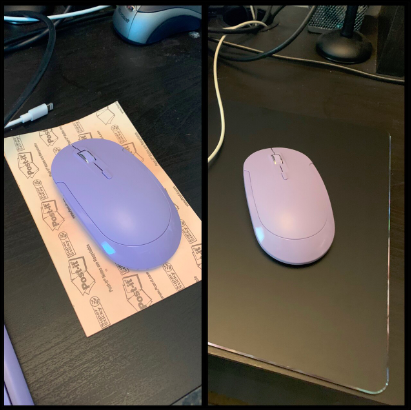How to bust workplace tolerations
Jeremie Miller, November 15, 2023
Once upon a time, I had a desk that was way too small. It was cluttered, cramped, and not conducive to being productive. While talking to me one day, my boss noticed the mess and said, “That desk is too small. You need a new desk.” She allowed me to purchase one, and work has been much more comfortable and productive. The desk cost about $100, but the agency has recouped that money just in the time I’ve been able to actually work and not resituate, reposition, seek, and find any and everything I need in my workspace.
- Joy Ingram, RAFT Workshop Facilitator
What Joy is sharing in her story is a toleration: “things that bug us, zaps our energy and could be eliminated” - Thomas Leonard.
Tolerations are devious because they often fly under our radar, and we don’t notice them. Or, we do notice them, and continuously think, “I’ll get to that later” or “It's not a big deal; I’m not going to worry about it.”
Unfortunately, we don’t have just one or two tolerations. You probably have a whole bunch of them. Each one barely registers in your mind, but when they all add up, they are stealing a surprising amount of your energy, frustrating you, and stressing you out.
Think of tolerations like phantom power or standby power in all your electronic devices. That little light on your appliance, even when the device is off, is draining power (and increasing your electricity bill).
- Closed laptop - phantom power.
- The “off” light on your TV - phantom power.
- Monitor asleep but not off - phantom power.
Estimates from the Canadian Natural Resources’ website estimate that up to 10% of a household’s energy bill is used by phantom power. For my family, that is $10 a month we are spending on little reminder lights around our home.
The tolerations in your life are costing you 10% of your daily energy (or more!).
Imagine what your day would be like if you reclaimed that energy. That energy could go towards your clients, your colleagues, your family, and your personal interests, or just be kept in reserve to make your days, weeks, and months more sustainable.
How to reclaim 10% (or more) of your energy - eliminate your tolerations

The good news is your tolerations can be eliminated; some for free, others at a low cost, and some that might have to wait until they fit into your budget.
The light bulb in my office takes about 2 minutes to warm up and give enough light to work. Fixed with a $3 light bulb from our local hardware store.
The internet router is downstairs, and I use an old 50ft tangled cable to run down the stairs and plug in for Zoom calls. Untangling that cable drives me crazy. Fixed with a $10 no-tangle cable from Amazon.
Finding notes for different projects in my “notebook of endless projects” uses up way too much of my day. Fixed with six thin 60-page notebooks, one for each project, for $28 (Bonus: each book has really nice paper to improve my writing enjoyment.)
My office chair is 13 years old, and I am now bottoming out on the cushioned seat. I don’t have the money for a new chair right now, so my office chair stays on my list of tolerations until I can fit a new chair into my budget.
Some tolerations are easy to bust, while others might take some time. However, for $5, $10, and $25, you can see that some of your tolerations can be eliminated, some of that stolen energy reclaimed, and your frustration eliminated. It doesn’t seem like much, but I actually give a small sigh of satisfaction every time I pull out that no-tangle internet cable and run it downstairs.
No money to spare at the moment? No problem. Many tolerations can be handled for free.
Papers and notebooks end up piling high on my desk, causing mental chaos and exhaustion. I solved this by creating a habit of cleaning my desktop at the end of each day. Starting the next day with a nicely organized desk removes the frustration of spending the first few minutes of each day trying to find what I need.
I was feeling tired by 11 a.m. each morning, and it turned out I was dehydrated. Now I match each cup of coffee I drink with a big glass of water. No dehydration, no desire to take a nap, and I am getting more done.
I kept walking to my bookshelf to grab a book I referenced constantly, so I made space on my desk, and the book now lives there within easy reach.
I have been struggling to write using my computer in my office. Now I am writing using pen and paper with a cup of coffee in our local coffee shop.
Now that you have an idea of what a toleration is, are you ready to reclaim 10% of your daily energy?
Here are some easy steps you can take to start eliminating your tolerations:
- Take 10 - 20 minutes and write down everything you are currently tolerating. Think about:
- Physical spaces in your life: workspaces, home office, kitchen, bedroom, bathroom, living room, car, how and where you sit on the bus, your favorite coffee shop, spaces that need to be cleaned, things that need to be fixed, etc.
- Physical items: computers, phones, appliances, furniture, storage, purse/wallet, backpack, clothing, shoes, glasses, etc.
- Habits and systems: the way you work, cook, exercise, sleep, wake up, relax, eat and drink schedule, etc.
- Relationships: friends and family, work colleagues, supervisors, volunteering, faith-based groups, etc.
- Your health: doctor appointments, dentists, massage, chiropractor, gym membership, etc.
- Hobbies: things you don’t like anymore, things you wish you did more, new things you would like to try, etc.
- (Thomas Leonard, a professional coach, said you can easily find 50 tolerations in about 10-20 minutes. Don’t focus on that specific number; just write down as many tolerations as possible or as many as you feel comfortable with to avoid feeling overwhelmed.)
- For each toleration on your list (or as many as you can, without feeling overwhelmed), write out the positive solution to this toleration.
- Look at a positive solution and estimate the cost to eliminate it. This cost may be free, a few dollars, or out of your price range.
- Looking at your list of tolerations, and list of positive solutions, pick one that is easy and within your budget to take care of right now. No, really, give it a try, and take care of that toleration now, then come back and finish reading this post.
- Once you eliminate that first toleration, keep going. Return to your list when you can, keep eliminating your tolerations, and add new ones. The more tolerations you eliminate, the more aware you will become of new tolerations.
How teams, leaders, and organizations can support the elimination of tolerations
Sexual and domestic violence advocates are dealing with a wide assortment of tolerations in their lives. It is important for teams, leaders, and organizations to support the elimination of these tolerations as much as possible. Eliminating tolerations shouldn’t be the responsibility of a lone advocate. The more you, as a leader, can support them in dealing with tolerations, the more sustainable the work becomes, and the healthier your team will be.
Supporting your team with tolerations can be free, low cost, or be given as big of a budget as you can manage.
Here is a simple way you can support your team with tolerations as part of a regular staff meeting:
- Set aside time (10-20 minutes) in a staff meeting for your team to do the toleration exercise above. Encourage conversations while people make their lists.
- Give each member of your team a budget to eliminate one or more of their tolerations:
- Give team members this money with no strings attached. TRUST your team.
- Each person decides how to spend this money (and add to it if they want) to eliminate their tolerations, however that looks for them.
- Give each team member time to eliminate their tolerations.
- Make sure your leadership team opens up time in your schedule to discuss tolerations. Your team may need to talk to you in order to eliminate one of their tolerations.
- At a later staff meeting, take time to discuss what tolerations team members eliminated.
- Openly sharing is optional. Remember you trust that your team eliminated tolerations; they don’t need to report in.
- Hearing other people’s toleration stories and solutions can help others solve their own.
- Keep the conversation going in future staff meetings, during one-on-one conversations, during reviews, etc. The more your organization can openly discuss what isn’t working, and what is draining their energy, the better.
As you get better at busting your tolerations, you can start identifying and dealing with tolerations in the moment. If you are ever feeling drained of energy, and can’t quite figure out why, review your current environment and try to find something (or multiple things) you are tolerating in that moment of low energy. Then, see if you can do something quick and easy to eliminate that toleration.
To help with your toleration-busting journey, here are some examples from the RAFT team:
Toleration-busting examples from the RAFT Team

$0 Tolerations
Maegan - moved my workspace out of my bedroom, which makes me feel more productive.
Sophie - I finally organized my “important papers” file box that has sat next to my desk for a year.
Joy - I took 5 minutes to rearrange the keys on my keychain so I could find my apartment key quicker.
Jeremie - my hamstrings are super tight and restrict my movement. So I started a 10-second hamstring stretch every time I walk upstairs to my office.
$5 Tolerations
Sophie - While working all day at my desk, my phone battery drains to zero. I bought a phone charger to use at my desk.
Maegan - I love taking notes and making task lists on paper, so I purchased a cute notebook that brings me joy when I write in it.
Jeremie - the light in my office takes about 2 minutes to warm up. I purchased a $3 light bulb that turns on instantly.

$10 Tolerations
Sophie - I have been using a notepad as a mouse pad for months. I purchased an extra smooth mousepad to replace the notepad.
Maegan - To help with my note-taking and task list writing, I purchased a “7-year pen,” which matches my value of buying sustainable items.
Joy - If I forget my sunglasses, I end up squinting while driving in the sunlight. I purchased a spare pair of sunglasses that I just leave in my car as a backup.
Jeremie - my router is all the way downstairs and requires a 50ft internet cable, which was always a tangled mess. I replaced it with an affordable no-tangle cable.
$25 Tolerations
Sophie - I often wish I could put my feet up under my desk while working, so I purchased a soft footrest to give me a different position while working.
Maegan – I purchased a monitor stand to help with the ergonomics of my desk area and to protect my neck.
Joy - I get neck pain while working at my computer. I purchased a wireless keyboard for my desk that allows me to raise my laptop to eye level while working.
Jeremie - I struggle to organize different projects all in the same notebook. I purchased six thin, 60-page, notebooks so each project has its own location.







